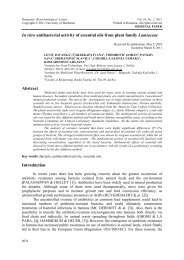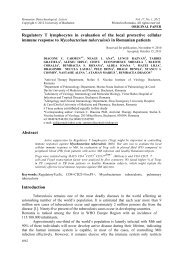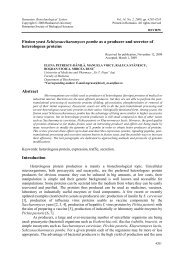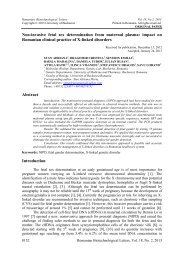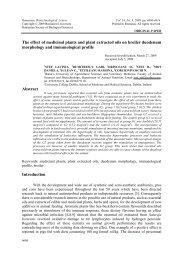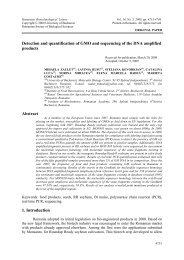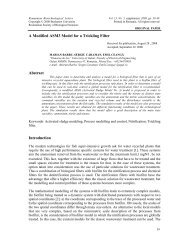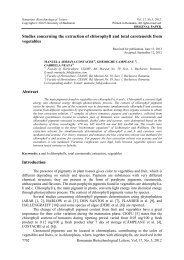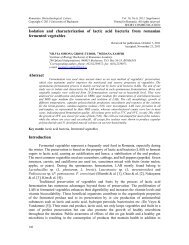ioana vasilescu, simona c. litescu, sandra . a. v. eremia - Rombio.eu
ioana vasilescu, simona c. litescu, sandra . a. v. eremia - Rombio.eu
ioana vasilescu, simona c. litescu, sandra . a. v. eremia - Rombio.eu
You also want an ePaper? Increase the reach of your titles
YUMPU automatically turns print PDFs into web optimized ePapers that Google loves.
Romanian Biotechnological Letters Vol. 18, No.2, 2013Copyright © 2013 University of BucharestPrinted in Romania. All rights reservedORIGINAL PAPERMethod of Cysteine/Cystine Ratio Assessment Suitable for PhysiologicalApplicationsAbstractReceived for publication, September 17, 2012Accepted, March 15, 2013IOANA VASILESCU a , SIMONA C. LITESCU a , SANDRA . A. V. EREMIA a ,RAMONA PENU a and GABRIEL-LUCIAN RADU a,b,*a Centre of B<strong>ioana</strong>lysis, National Institute for Biological Sciences, 296 Spl. Independentei,Bucharest, Romaniab Politehnica University of Bucharest, Faculty of Applied Chemistry and Material Science, 1-7Polizu Street, Bucharest, Romania.Corresponding author: GABRIEL LUCIAN RADUE-mail: gl_radu@chim.upb.ro; Tel/Fax : 0212239070A fluorimetric method for the determination of cysteine (CSH) and cystine (CSSC) atnanomolar concentrations is reported. The detection limit was 2.46x10 -11 M for CSH whenderivatisation is performed by 5-iodoacetamidofluorescein (5-IAF) and respectively 7.2x10 -10 M whenmonobromobimane was used as fluorescent reagent. The dynamic range of analytical response was3x10 -10 - 3x10 -8 M (in the case of CSH-5-IAF). The method was further applied to determine the[CSH]/[CSSC] ratio at nanomolar concentration levels as potential marker of aminoacids oxidativestatus. An original algorithm to calculate the exact concentrations for each form was established, beingprovided even the experimental data to support it. Zinc influence on avoiding CSH oxidation wasstudied. Data were confirmed by high-performance liquid chromatography with fluorescence detection.Keywords: cysteine, cystine, fluorescence-derivatisation, zinc-cysteine complex, HPLC.IntroductionReversible redox reactions characteristic for thiols are essential in many biologicalsystems. Mainly, the reported data on thioaminoacids analysis are based on the changes of theredox status, the usual employed analytical techniques being chromatography (A.Z.S. Sotgia& al. [1], H. Alwael & al. [2]) electrochemical (J.-B. Raoof & al. [3], D.R.Do Carmo & al. [4],Z. Jia & al. [5], A. Nosal-Wiercińska [6]) spectrophotochemical (K. S. Lee & D. Drescher[7], Y. Wang & al [8]) and fluorescent (A. Pastore & al. [9], S.V. Suresh Babu & al. [10], R.Kandar & al. [11]) ones. Usually studies on the amino acid content of physiological fluidshave been carried out under conditions that would allow any cysteine present to be oxidized tocystine prior analysis.M. P. Brigham has developed a method for the determination of cysteine and cystineindividually in the same sample of plasma based upon the fact that iodoacetate reacts rapidlywith cysteine to convert it quantitatively to the stable S-carboxymethyl derivative, which can bedetermined by chromatography coupled with fluorescent detection (M. P. Brigham & al. [12]).With several exceptions, thioaminoacids do not exhibit a genuine fluorescence, theirfluorescent detection being based on derivatisation using a fluorescent reagent.Thioaminoacid fluorescent determination is used due to the high sensitivity of the technique(O. Rusin & al. [13], X.F Yang & al. [14]).Extracellular thiol/disulfide redox environments are highly controlled in variousbiological processes (cardiovascular disease (CVD), type 2 diabetes, age, smoking, obesityand alcohol abuse). The major thiol/disulfide redox couple in human plasma is cysteine(CSH) and its disulfide form, cystine (CSSC) (Y.M. Go & al. [15], [16]).8170 Romanian Biotechnological Letters, Vol. 18, No. 2, 2013
IOANA VASILESCU, SIMONA C. LITESCU, SANDRA A. V. EREMIA,RAMONA PENU and GABRIEL-LUCIAN RADUSpectrofluorimetric determination of thiols in biological samples can be performedusing various fluorescent reagents, an example being 3-maleimidylbenzanthrone (3-MB).When 3-MB conjugated to a thiol, a strong fluorescent derivative is formed. According toN.N. Fu & al [17], the fluorescence intensity proved to be linear in the range of 10 -8 - 6x10 -7M for cysteine and 6x10 -9 - 4x10 -7 M for glutathione (GSH). The reported detection limit was5.7x10 -9 M for CSH and 5.6x10 -9 M for GSH. The method has been applied to thedetermination of GSH in human serum, plasma, and CSH in urine. Other methods applied ondetermination of thiols in physiological samples are based on previous chromatographicseparation with specific electrochemical detection, using specific electrodes, as reported forhomocysteine and its derivatives (S. Martin & al. [18]).The main goal of the present work was to develop an analytical method for thedetermination of the CSH/CSSC ratio at nanomolar concentration levels, suitable forapplications on physiological samples and able to provide reliable data in order to rationalizeon the influence induced on CSH/CSSC ratio by certain metals, in our case zinc (Zn). Thedevelopment of a simple analytical method capable to provide information with respect toCSH/CSSC ratio and Zn influence is valuable when the role of the metal on metalloproteinasesdisruption has to be assessed.Two different fluorescent reagents were used for derivatisation, namely,monobromobimane (BrB) - due to its high specificity toward –SH groups, resulting highlyemitting fluorescent compounds following reaction (1) and 5-IAF - due to the stability of theresulting products at physiological pH (F. Vogel & L. Lumper [19], L.A. Ralat & R.F.Colman [20], A.R. Ivanov & al. [21]).Monobromobimane is a fluorescent hydrophobic compound, superior to otherfluorescent thiol-specific reagents with respect to group specificity as well as to the chemicalstability and photochemical properties of its reaction product with L-cysteine.OOOONCH R-SHNH 3 C3HN-HBr 3 CCH 3NBrCH 2 CH 3 RSCH 2 CH 35-Iodoacetatmidofluorescein is soluble in buffer solutions at pH > 6.00 and it is one ofthe most frequently used fluorescence reagents (J. R. Cupp & L. E. Vickery [22]).As mentioned above, zinc was chosen due to the fact that there are reported data aboutthe activation of cellular metalloproteinases via a “cysteine switch” mechanism through thedisruption of the interaction between the cysteine-sulphydril group and the zinc ion (F.Mannello [23]).Zinc is a metal that has important roles in the metabolic function of the body due to itsimplication in enzymatic mechanism on the human body level. On the proteins level thatcontains active zinc-binding sites, the zinc ion is coordinated by different possible systems,such as the nitrogen of histidine, the oxygen of aspartate or glutamate and the sulfur ofcysteine (D.S. Gregory & al. [24]). The zinc-cysteine complex system is a redox-activesystem. Oxidation of the sulfur ligands determines increased zinc mobility, while the presenceof many reducible sulphydril ligands enhances the zinc coordination; therefore in vivoavailability of zinc ions can be controlled by redox processes (M. Wolfgang [25]). At the sametime it should be specified that the zinc presence reduces the degree of CSH oxidation thusavoiding the CSSC accumulation, and consequently avoiding the ageing phenomena (it isknown that higher amounts of CSSC are associated to oxidative stress and degenerativeRomanian Biotechnological Letters, Vol. 18, No. 2, 2013 8171
Method of Cysteine/Cystine Ratio Assessment Suitable for Physiological Applicationsdiseases). In this context it seemed important to develop an analytical method able to monitorthe Zn-CSH complex at very low concentration limits (nanomolar, nM, and less than nM)(D.A. Newsome & D. Tate [26]).Materials and MethodsReagents and chemicals: All the used reagents, L-cysteine (Fluka), L-cystine (Fluka),monobromobimane and 5-iodoacetamidofluorescein (Sigma), tris (2-carboxyethyl) phosphinehydrochloride (Fluka), potassium phosphate monobasic and dibasic (Sigma), zinc sulfate(Sigma), hydrochloric acid (Sigma) and methanol (Sigma-Aldrich) were at least of analyticalpurity. All aqueous solutions were prepared in ultra-pure water, Millipore.Apparatus: A LS 45 Model Perkin Elmer spectrofluorimeter was used, alldeterminations being performed at 25°C using a quartz path-length cell of 1 cm, the appliedvoltage being 650 V.The high performance liquid chromatography (HPLC) measurements were performedusing a Jasco system comprising a PU - 1580 Intelligent Pump, a Jasco DG – 2080 – 544 –Line Degasser, a Jasco LG – 1580 – 02 Ternary Gradient Unit, and fluorometric detector FP –2020 – PLUS Intelligent, the analysis software was Borwin. The samples were separated on aKromasil 100 C 18 5 µm, 250x4.6 mm column.Cysteine derivatisation: L-cysteine 3x10 -7 M was conjugated with 5-IAF 6x10 -7 M in0.1 M phosphate buffer solution pH 7.00. The sample was allowed 2 h to stabilize at roomtemperature. When BrB was used as fluorescent reagent L-CSH 10 -7 M was labeled with BrB4x10 -7 M in 0.01 M potassium phosphate solution adjusted to pH 3.60. In this case a 36 hincubation time was necessary. It has to be mentioned that those were the optimizedconditions, subsequent testing various temperature, pH and incubation time conditions.Spectrofluorometric condition: The experimental parameters for CSH-5-IAF were -the excitation wavelength (λ exc ) of 490 nm, while the emission wavelength (λ em ) of 670 nm;for CSH-BrB the λ exc of 370 nm and λ em of 490 nm, cell pathway 1 cm.Chromatographic conditions: An isocratic HPLC method was developed for the CSH-BrB derivate. The mobile phase consisted from two components, in a mixture ratio A:B of75:25, established as optimal for proper elution, based on peak shapes and resolution. The Acomponent of mobile phase was phosphate buffer (0.01 M, pH = 3.60) : methanol (2:1, v/v),while B component of the mobile phase was acetonitrile. The optimum flow rate wasestablished as being 0.7 mL/min. The fluorescence detector was set to a λ exc of 370 nm and aλ em of 490 nm. Injection volume was 20 μL. Each determination was performed in fivereplicas.Results and DiscussionsCysteine and cystine are not fluorescent compounds, their fluorescence occurringsubsequently to derivatisation with appropriate reagents. Two reagents were used, namelyBrB and 5-IAF, both of them being slightly fluorescent. After derivatisation the resulted thiolderivativesbecame highly fluorescent.To develop an analytical method to determine the ratio between the oxidized and thereduced forms of CSH it is necessary to establish a proper analytical method to detect bothforms with high sensitivity.It should be mentioned that any change in the fluorescent intensity correlates onlywith CSH content (Fig. 1-A), due to the fact that derivatisation of CSSC with 5-IAF does notoccur. Therefore, it could be possible to determine both oxidized and reduced forms.Romanian Biotechnological Letters, Vol. 18, No. 2, 2013 8172
IOANA VASILESCU, SIMONA C. LITESCU, SANDRA A. V. EREMIA,RAMONA PENU and GABRIEL-LUCIAN RADUThe proof of the hypothesis correctness was obtained when an equimolar mixture ofCSH and CSSC was analyzed; after 5-IAF derivatisation the fluorescent intensity found forthe mixture was quite similar to that of CSH-fluorescent derivative (Fig. 1-B). Asconsequence, both the oxidized and the reduced forms are available for simultaneousdetermination, via CSSC reduction prior fluorescent derivatisation.Fig. 1. Emission spectra of: (A) 1) CSH - 5-IAF; 2) 5-AF; 3) CSSC : 5-IAF and respectively (B) a) CSH - 5-IAF; b) CSH - CSSC - 5-IAFWhen CSH underwent derivatisation according to the optimal procedure (as presentedin procedure section) it was found that the best results in terms of fluorescence intensity,stability and sensitivity are obtained for a combination ratio of 4:1 BrB to CSH. In theseconditions when an equimolar mixture of CSH and CSSC was subjected to simultaneousderivatisation and analysis it was observed, as expected, that only the reduced form reactedproperly with BrB. Therefore the same conclusions were drawn even for BrB use asderivative reagent as for 5-IAF: it is possible to analyze both forms only if initially the CSHamount is well-determined and CSSC underwent reduction and then fluorescentderivatisation.In optimal experimental conditions the performance characteristics forspectrofluorimetric analysis were determined (Table 1).Table 1. Performance characteristics for spectrofluorimetric method of CSHFluorescentDynamic rangeEquation of calibration curvereagent(M)I5-IAFem (units) = 0.35x10 +10 C(M) – 0.48R = 0.9982IBrBem (units) = 2.88x10 +9 C(M) + 1.04R = 0.9999n = 10 measurementsLOD(M)RSD%3x10 -10 – 3x10 -8 2.4x10 -11 1.210 -9 –10 -7 7.2x10 -10 0.8The detection limit at nanomolar level enables the determination of the CSH/CSSC ratioin a single experimental step, even if the sample pretreatment may seem slightly laborious.Despite all derivatisation steps, in fact it is easy to be performed.A method to calculate the ratio between the oxidized and the reduced form of thio-Romanian Biotechnological Letters, Vol. 18, No. 2, 2013 8173
Method of Cysteine/Cystine Ratio Assessment Suitable for Physiological Applicationsaminoacids was developed using the spectrofluorimetric method, the reduction of the oxidizedform being applied.The method is applied in different steps:i. aliquotation of the artificial mixture CSH-CSSC ( respectively real sample);ii. determination of initial concentration of CSH from the mixture (artificial mixture orsample), using one aliquot that was subjected to fluorescent derivatisation andspectrofluorimetric determination by applying the developed method;iii. reducing CSSC to CSH using a second aliquot, by phosphine reaction (H. ALWAEL & al.[2]), followed by fluorescent derivatisation of whole mixture and, subsequently,spectrofluorimetric determination of total CSH-derivative;iv. determination of CSSC amount by subtraction of initial CSH amount (result of step ii)from total CSH (result of step iii) previously determined.It should be mentioned that phosphine derivatives are not interfering in the fluorescentdeterminations; therefore they should not be removed from the measuring system.Several experiments were performed to prove the proper application. In this way asolution of 3x10 -7 M of CSH was derivatized with 5-IAF and the fluorescence intensity wasmeasured (the effective concentration in the measuring cell was 3x10 -8 M); then 0.5 mMCSSC underwent reduction (reaction below) by 1.25 mM tris 2-carboxyethyl phosphinehydrochloride, (previously both solutions were deoxygenated by Argon purge, 30 min).The reduction was allowed to occur for 2 h, and then it was brought to a concentrationof 3x10 -7 M in phosphate buffer. This solution was subjected to fluorescent derivatisation. Thefluorescence intensity of the derivatized compound was measured in the optimal experimentalconditions, previously presented. Comparing the obtained values of the fluorescence intensityfor the first solution with that obtained for the reduced CSSC, it was noticed that theycorrespond to 2:1 stoichiometry of reduction reaction.When an equimolar mixture of CSH and CSSC was subjected to a similar procedureof reduction followed by derivatisation, working with concentration levels of 3x10 -8 M, afluorescent intensity for the mixture that equals the sum of the fluorescence intensities wasobtained, separately for CSH-derivative and reduced CSSC-derivative. For example, for amixture of CSH and CSSC reduced and derivatized the value of fluorescence intensity isabout 0.14 units, while the sum of intensities between CSH-derivative and reduced CSSCderivativeis 0.13 units. The RSD for 3 measurements was 7.4 %.Consequently it could be rationalized that a calculation method could be establishedstarting from obtained results, as follows: if CSH standard is the CSH standard solution, ofknown concentration, [CSH] std , the associated fluorescence intensity value measured forstandard solution is ΔI std . With this value determined, the standard solution will be used tospike the unknown sample, S, which should be evaluated for CSH/CSSC ratio. The measuredfluorescence value, ΔI std, will be used too in further calculations.Let us assume that S is the sample where the CSH/CSSC ratio should be determined.The sample contains initially an unknown concentration of reduced form of CSH, and, ofcourse, a certain amount of CSSC (the oxidized form). The existing concentration of reducedform is noted [CSH] sample while the concentration of the oxidized form is [CSSC] sample .To the sample to be assessed, S, it is further added a concentration [CSH] std ofcysteine, standard solution (known concentration, that used to determine the ΔI std value). Themixture resulted (sample and standard solution) is further aliquoted. The first aliquot ofspiked sample is derivatized with fluorescent reagent and the fluorescence intensity ismeasured, resulting ΔI sample , value ascribed to a CSH concentration equaling ([CSH] sample +[CSH] std ), because as mentioned, the unreduced CSSC does not interfere in determination. AsRomanian Biotechnological Letters, Vol. 18, No. 2, 2013 8174
IOANA VASILESCU, SIMONA C. LITESCU, SANDRA A. V. EREMIA,RAMONA PENU and GABRIEL-LUCIAN RADUconsequence, according to standard additions, Eq. (1):[ CSH ]stdΔI=CSH + CSH ΔI([ ]sample[ ]std)samplestd(1)Accordingly, the reduced form in the sample will be, Eq. (2):[ CSH ]std⋅ ( ΔIsample− ΔIstd)[ CSH ]sample= (2)ΔIstdThe second aliquot of spiked sample is firstly reduced via phosphine, using a solutionof 1.25 mM tris 2-carboxyethyl phosphine hydrochloride in order to perform the completereduction of the CSSC occurring in the sample S. Further on the reduced mixture isderivatized, the fluorescence intensity being measured; the obtained value, ΔI total reduced , iscorresponding to a total concentration of cysteine ([CSH] sample +2[CSSC] sample +[CSH] std ),based on the reaction stoichiometry for CSSC reduction, that is 2. Consequently, thefollowing equation is obtained, Eq. (3):[ CSH ]stdΔIstd=(3)CSH + 2 CSSC + CSH ΔI(4):([ ]sample[ ]sample[ ]std)totalreducedTaking into account Eq. (2), then the concentration of the oxidized form will be Eq.[ CSSC][ CSH ] ⋅ ( ΔI− ΔI)std totalreduced samplesample=(4)2 ⋅ ΔIstdConsequently, according to the measured fluorescent intensities values, the ratio of thereduced form CSH to oxidized form CSSC can be directly calculated as, Eq. (5):[ CSH ]sample⋅ ( ΔIsample− ΔIstd)= 2 (5)CSSC ΔI− ΔI[ ]sample( )totalreducedTaking into account that the presence of zinc ions is decreasing the degree of CSHoxidation avoiding thus the CSSC accumulation, it is important to study if the developedanalytical method is applicable to detect the Zn-CSH complex at very low concentrationlimits (nanomolar and less than nM).To evaluate the zinc influence against CSH/CSSC ratio the changes on fluorescenceintensities for each compound in zinc presence were determined, using two approaches:1. Simultaneous addition of all measuring system components: cysteine, zinc ion,fluorescence reagent;2. Complexation Zn-CSH followed by fluorescent derivatisation.For a combination ratio Zn-CSH 1:1 when the simultaneous addition of allcomponents is performed no difference was noticed between the values obtained for CSHderivativeitself or when zinc is added to the system (the intensity increased only with 5.04units at concentration levels of 3x10 -7 M). This lack of sensitivity could be ascribed tocompetitive reactions between the system components.When the second approach is performed, the formation of Zn-CSH complex is allowedto occur 12 h, and then the derivatisation with 5-IAF is performed for 2 h, up to reachingstability, a significant increase in fluorescent intensity being observed (to a value of 22.77units) with respect to the value obtained for CSH–5-IAF derivative (Fig. 2).sampleRomanian Biotechnological Letters, Vol. 18, No. 2, 2013 8175
Method of Cysteine/Cystine Ratio Assessment Suitable for Physiological ApplicationsFig 2. The influence of Zn on CSH-5-IAF: 1) Zn - CSH - 5-IAF complexation followed by derivatisation; 2) Zn -CSH – 5-IAF simultaneous derivatisation; 3) CSH - 5-IAFConsequently, the monitoring of Zn-CSH level under 10 -7 M values could be done. Itshould be mentioned that Zn (II) itself does not interfere in the fluorescent determinations.Considering the fact that Zn–CSSC does not couple with 5-IAF, the values offluorescence intensity of the mixture Zn–CSSC–5-IAF are equal to the 5-IAF fluorescenceintensity (5-IAF I em = 109.3 units while Zn–CSSC–5-IAF I em = 108.5 units) thus it could beconcluded that the addition of Zn (II) 10 -7 M in an equimolar mixture of CSH-CSSC preventsthe further CSH oxidation. Moreover, the Zn presence in such measuring system increasedmethod sensitivity, due to the fact that the fluorescence intensity of Zn–CSH–5-IAF is 21 %higher than CSH–5-IAF fluorescence intensity.In the rationale of the importance of result confirmation, another sensitive method,able to discriminate the interest analyte – CSH – from complex matrix (such are physiologicalones) at nanomolar concentration levels was used. Therefore a chromatographic method(HPLC) based on fluorescence detection (FL) was developed and applied for the cysteinedetermination.The overlaid HPLC-FL chromatograms of the CSH-BrB and fluorescent reagent aregiven in figure 3. In the used separation conditions it was proved that the retention timecharacterizing CSH-BrB was t R = 3.51 min (CV=0.16 %). As observable from figure 3,another three peaks appeared which were ascribed to the fluoro-reagent used in derivatisation,since their areas and retention times are not changing with CSH concentration. Thereproducibility of the CSH retention times and peak areas was investigated by injecting CSH-BrB five times under the same conditions, and the obtained coefficients of variation (CV) forretention times and peaks areas were less than 0.2% for both parameters.Romanian Biotechnological Letters, Vol. 18, No. 2, 2013 8176
IOANA VASILESCU, SIMONA C. LITESCU, SANDRA A. V. EREMIA,RAMONA PENU and GABRIEL-LUCIAN RADUFig 3. Chromatogram of CSH–BrB 5x10 -8 MIn the same experimental conditions, a fluorescent derivatized mixture containingCSH-CSSC was injected and no specific peak for CSSC derivative was observed in theworking conditions. This conclusion was expected, and it was supported also by the resultsobtained by fluorescence spectrometry, and confirmed by the specificity of used reagenttoward –SH groups from aminoacids.The high selectivity and the reproducibility of the proposed method (table 2) sustainedthe assumption that the HPLC-FL developed method applicable in the determination of thecompound of interest at nanomolar levels.Table 2. Analytical performance data.tCompound R , Linear rangemin MCalibration curveequationCSH 3.51 3.6x10 -9 -3x10 -7 A=7x10 +12 C(M)–2168,1R = 0.9990LoD, M(3xS/N)LoQ, M(10xS/N)RSD%1.2x10 -10 4.1x10 -10 4.81Since the influence of Zn on CSH/CSSC ratio modulation was demonstrated byspectrometric method previously reported, in the same rationale of data confirmation HPLC-FL analysis of the complex Zn-CSH was performed, using two combination ratios Zn:CSH,namely 1:2 and 1:1 respectively, using the optimal derivatisation time as earlier. Theanalytical performances of HPLC-FL method for the complex Zn-CSH- BrB are shown intable 3.Table 3. The analytical performances of the complex Zn-CSH–BrBZn:CSHLinear range, M Calibration curve equationratio1:1 6x10 -9 ÷ 2x10 -7 A=2x10 +12 C(M)–1592.8R=0.99941:2 5.1x10 -9 ÷ 2x10 -7 A = 9x10 +12 C(M)–38698R=0.9981LoD, M(3xS/N)LoQ, M(10xS/N)3.2x10 -9 1.7x10 -81.7x10 -9 4.4x10 -9It is important to stress out that the dynamic linear range ranging on two decades isRomanian Biotechnological Letters, Vol. 18, No. 2, 2013 8177
Method of Cysteine/Cystine Ratio Assessment Suitable for Physiological Applicationsmaintained and are a bit improved in both cases, for cysteine and for Zn-CSH complex withrespect to reported data (H. Alwael & al. [2]). The values of LoD and LoQ supported theallegation of method application on physiological samples analysis.According to the obtained data it should be mentioned that spectrofluorimetric methoddeveloped by us is a viable alternative to HPLC determinations.Further, in order to check the spectrofluorimetric method applicability, its usefulnessin real samples was tested, using 24 hours collected urine of dogs with cystinuria diagnostic.A small volume of urine was diluted 10 times with buffer (pH 3.90), to provide theexperimental conditions as used in method development. Two aliquots of equal volumes weretaken. The first one was subjected to fluorimetric analysis being subjected to the all steps ofsample treatment as described when algorithm was established, as it was; the second one wasspiked with CSH prior to analysis. Subsequent samples fluorimetric analysis obtained datalead to the following results: CSH content in urine sample 723x10 -6 mol g -1 and 643x10 -6 molg -1 , respectively, for sample with and without spiked standard. The calculated CSH recoverywas about 90 %. The method may be applied on real samples but is affected by thecomposition of the matrix sample (loosing about 10 % of the real content).ConclusionsA spectrofluorometric method for simultaneous determination of CSH and CSSC wasdeveloped and obtained results proved to be compatible with those obtained by an in-housesettled HPLC-FL. The optimized spectrofluorimetric method had a detection limit of 2.46x10 -11 M for CSH, when 5-IAF was used as fluorescence-derivative reagent. The linearity ofanalytical response, ranging on two decades, was 3x10 -10 - 3x10 -8 M. Both performancecharacteristics were better than those reported since now (H. Alwael & al. [2]).The method was applied to determine the CSH/CSSC ratio at nanomolar concentrationlevels, a calculation method being established and supported by experimental data. Takinginto account the performance characteristics of the developed methods, as long as theobtained recovery from real samples, it could be assumed the method applicability tophysiological samples. According to M.P. Brigham et al. [12], the CSH level on humanplasma is 0.4 mg per 100 mL.The zinc addition in a mixture of oxidized and reduced CSH prevented the CSHoxidation. Moreover, a considerable increase of the method sensitivity (more than 20 %) wasobserved. According to presented data it could be concluded that applying the developedmethod is eventually possible the determination of Zn influence on CSH/CSSC ratio atnanomolar level.References1. A. ZINELLU, S. SOTGIA, B. SCANU, E. PISANU, M. SANNA, S. SATI, L. DEIANA, S. SENGUPTA,C. CARRU, Talanta, 82(4), 1281-1285 (2010).2. H. ALWAEL, D. CONNOLLY, L. BARRON, B. PAUL, Development of a rapid and sensitive method fordetermination of cysteine/cystine ratio in chemically defined media. J. Chromatogr. A, 1217(24), 3863-3870(2010).3. J.-B. RAOOF, R.OJANI, H. BEITOLLAHI, L-Cysteine Voltammetry at a Carbon Paste Electrode Bulk-Modified with Ferrocenedicarboxylic Acid. Electroanalysis, 19(17), 1822-1830 (2007).4. D. R. DO CARMO, R. M. SILVA AND N. R. STRADIOTTO, Electrocatalytic and voltammetricdetermination of sulfhydryl compounds through iron nitroprusside modified graphite paste electrode. J.Braz. Chem. Soc., 14(4), 616- 620 (2003).5. Z. JIA, K. DING, Q. ZHAO, J. CAO, R. TONG, Electrochemical response of polyaniline (PANI)/Thiokolrubber (TR) film in cysteine solution. J. Chin. Chem. Soc., 48(1), 25-32 (2001).Romanian Biotechnological Letters, Vol. 18, No. 2, 2013 8178
IOANA VASILESCU, SIMONA C. LITESCU, SANDRA A. V. EREMIA,RAMONA PENU and GABRIEL-LUCIAN RADU6. A. NOSAL-WIERCIŃSKA, The catalytic activity of cysteine and cystine on the electroreduction of Bi(III)ions. J. Electroanal. Chem., 662(2), 298-305 (2011).7. K. S. LEE, D.G DRESCHER, Derivatization of cysteine and cystine for fluorescence amino acid analysiswith the o-phthaldialdehyde/2-mercaptoethanol reagent. J. Biol. Chem., 254(14), 6248- 6251 (1979).8. Y. WANG, J. WANG, F. YANG, X. YANG, Spectrophotometric determination of cysteine with goldnanoparticles stabilized with single-stranded oligonucleotides. Anal Sci., 10, 545-549 (2010).9. A. PASTORE, R. MASSOUD, A. L. RUSSO, G.. FUCCI, G. FEDERICI, Fully automated assay for totalhomocysteine, cysteine, cysteinylglycine, glutathione, cysteamine, and 2-mercaptopropionylglycine inplasma and urine. Clin. Chem., 44(4), 825-832 (1998).10. S.V. SURESH BABU, M.M. SHAREEF, A.P. SHETTY, K.T. SHETTY, HPLC method for amno acidsprofile in biological fluids and inborn metabolic disorders of aminoacidopathies. Indian J. Clin. Biochem.,17(2), 7-26 (2002).11. R. KANDAR, P. ZAKOVA, H. LOTKOVA, O. KUCERA, Z. CERVINKOVA, Determination of reducedand oxidized glutathione in biological samples using liquid chromatography with fluorimetric detection. J.Pharm. Biomed. Anal., 43 (4), 1382-1387 (2007).12. M. P. BRIGHAM, W. H. STEIN, S. MOORE, The concentrations of cysteine and cystine in human bloodplasma., J. Clin. Invest., 39(11), 1633-1638 (1960).13. O. RUSIN, N.N.ST. LUCE, R.A. AGBARIA, J.O. ESCOBEDO, S. JIANG, I.M. WARNER, F.B. DAWAN,K. LIAN, R.M. STRONGIN, Visual Detection of Cysteine and Homocysteine. J. Am. Chem. Soc,.126(2),438-443 (2004).14. X.F YANG, P. LIU, L. WANG, M. ZHAO, A chemosensing ensemble for the detection of cysteine based onthe inner filter effect using a rhodamine B spirolactam. J. Fluoresc., 18(2), 453-459 (2008).15. Y.M. GO, D. P. JONES, Cysteine/cystine redox signaling in cardiovascular disease. Free Radic. Biol. Med.,50(4), 495-509 (2011).16. Y.M. GO, H. PARK, M. KOVAL, M. ORR, M. REED, Y. LIANG, D. SMITH, J. POHL, D. P. JONES, Akey role for mitochondria in endothelial signaling by plasma cysteine/cystine redox potential. Free Radic.Biol. Med,. 48 (2), 275-283 (2010).17. N.N. FU, H. WANG, M.-L. LI, G. J. ZHENG, H.-S. ZHANG, S.-C. LIANG, Spectrofluorimetricdetermination of thiols in biological samples with a new fluorescent probe 3-maleimidylbenzanthrone. Anal.Lett., 38(5) 791-802 (2005).18. S. MARTIN, I. TSAKAS-AMPATZIS, W. BARTLETT, A. JONES, Measurement of total homocysteine byHPLC with coulometric detection. Clin. Chem., 45, 150-152 (1999).19. F. VOGEL, L. LUMPER, Fluorescence labelling of NADPH-cytochrome P-450 reductase with themonobromomethyl derivative of syn-9,10-dioxabimane. Biochem. J., 215 (1), 159-166 (1983).20. L. A. RALAT, R.F. COLMAN, Monobromobimane occupies a distinct xenobiotic substrate site inglutathione S-transferase π. Protein Sci., 12 (11), 2575-2787 (2003).21. A.R. IVANOV, I.V. NAZIMOV, L. BARATOVA, A.P. LOBAZOV, G.B. POPKOVICH, Determination ofbiologically active low-molecular-mass thiols in human blood - III. Highly sensitive narrow-bore isocraticreversed-phase high-performance liquid chromatography with fluorescence detection. J. Chromatogr. A.,913 (1-2) 315-318 (2001).22. J.R. CUPP, L.E. VICKERY, Identification of free and [Fe 2 S 2 ]-bound cysteine residues of adrenodoxin. J.Biol. Chem., 263, 17418- 17421 (1988).23. F. MANNELLO, Natural bio-drugs as matrix metalloproteinase inhibitors: New perspectives on the horizon.Recent Patens on Anti-Cancer Drug Discovery, 1(1), 91-103 (2006).24. D.S. GREGORY, A.C.R. MARTIN, J.C. CHEETHAM, A.R. REES, The prediction and characterization ofmetal binding sites in proteins. Prot. Eng., 6(1), 29-35 (1993).25. W. MARET, Zinc Coordination Environments in Proteins as Redox Sensors and Signal Transducers.Antioxidants & Redox Signaling, 8(9-10) 1419- 1441 (2006).26. D.A. NEWSOME, D. TATE, Patent US 6,586,611 July 2003.Romanian Biotechnological Letters, Vol. 18, No. 2, 2013 8179



